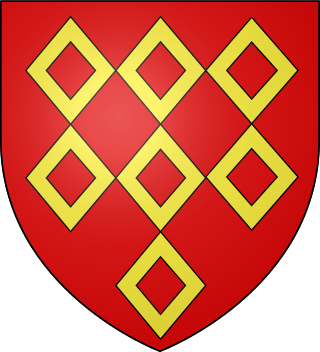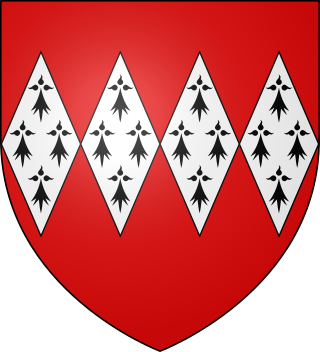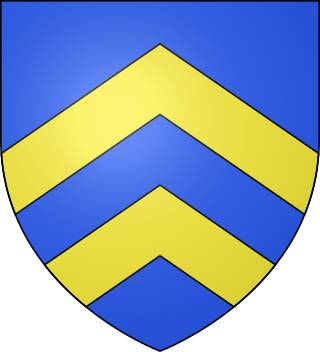Related Research Articles

Earl of Devon was created several times in the English peerage, and was possessed first by the de Redvers family, and later by the Courtenay family. It is not to be confused with the title of Earl of Devonshire, held, together with the title Duke of Devonshire, by the Cavendish family of Chatsworth House, Derbyshire, although the letters patent for the creation of the latter peerages used the same Latin words, Comes Devon(iae). It was a re-invention, if not an actual continuation, of the pre-Conquest office of Ealdorman of Devon.

Baron Stafford, referring to the town of Stafford, is a title that has been created several times in the Peerage of England. In the 14th century, the barons of the first creation were made earls. Those of the fifth creation, in the 17th century, became first viscounts and then earls. Since 1913, the title has been held by the Fitzherbert family.

Baron Strange is a title which has been created four times in the Peerage of England. Two creations, one in 1295 and another in 1326, had only one holder each, upon whose deaths they became extinct. Two of the creations, that of 1299 and that of 1628, are extant. The surname Le Strange was Latinized as Extraneus. The arms of Le Strange of Knockin Castle in Shropshire were: Gules, two lions passant argent.
Baron Lisle was a title which was created five times in the Peerage of England during the Middle Ages and Tudor period, and once in the Peerage of Ireland in the 18th century.

Baron Hunsdon is a title that has been created three times.

Baron Ferrers of Groby was a title in the Peerage of England. It was created by writ on 29 December 1299 when William Ferrers, 1st Baron Ferrers of Groby was summoned to parliament. He was the son of Sir William de Ferrers, Knt., of Groby, Leicestershire, (d.1287) by his first wife Anne Durward, 2nd daughter of Alan Durward and his wife Margery of Scotland, and grandson of William de Ferrers, 5th Earl of Derby. The first Baron was married to Ellen de Menteith, daughter of Alexander, Earl of Menteith. In 1475 the eighth baron was created the Marquess of Dorset, and the barony in effect merged with the marquessate. It was forfeited along with the marquessate when the third marquess was attainted in 1554.
Joan Chaworth was the heiress of the manor of Alfreton. Her father was Sir William Chaworth.
The title Baron Ferrers of Chartley was created on 6 February 1299 for John de Ferrers, son of Robert de Ferrers, 6th Earl of Derby. The daughter of the 6th Baron Ferrers of Chartley, Anne, married Walter Devereux who was summoned to parliament as Lord Ferrers in her right. Their descendants became Earls of Essex and the peerage was forfeited in 1601 on the attainder of Robert Devereux, 2nd Earl of Essex, but restored to his son Robert in 1604, on whose death in 1646 the peerage fell into abeyance. The abeyance was terminated in 1677 when Robert Shirley, a grandson of one of the sisters of the 3rd Earl of Essex, was summoned as Lord Ferrers of Chartley with precedence to the original creation. In 1711, Shirley was created the 1st Earl Ferrers, but the Earldom and Barony separated at his death, the barony going to Elizabeth Shirley, the daughter of his eldest son, while the earldom went to his second son. On the 1741 death of Elizabeth Shirley, 15th Baroness Ferrers of Chartley and wife of the Earl of Northampton, the peerage again briefly fell into an abeyance that was resolved in 1749 by the death of two of the three heiresses, leaving the surviving daughter, Charlotte Compton, wife of the Marquess Townshend, as 16th Baroness Ferrers of Chartley. The barony continued, merged with the marquessate, until the death of George Ferrars Townshend, 3rd Marquess Townshend in 1855, when it again fell into abeyance between his two sisters and their heirs. It remains in abeyance.
The title Baron Latimer or Latymer has been created, by the definitions of modern peerage law, four times in the Peerage of England. Of these, one was restored from abeyance in 1913; one is forfeit; the other two are dormant, although their heir is well known.
A writ in acceleration, commonly called a writ of acceleration, is a type of writ of summons that enabled the eldest son and heir apparent of a peer with more than one peerage to attend the British or Irish House of Lords, using one of his father's subsidiary titles, during his father's lifetime. This procedure could be used to bring younger men into the Lords and increase the number of capable members in a house that drew on a very small pool of talent.

The title Baron Moels was created once in the Peerage of England, in 1299, and passed into abeyance with the death of the fourth lord in 1337. The four men who by modern usage are held to have been Barons Moels were:

The titles Baron Montacute or Baron Montagu were created several times in the Peerage of England for members of the House of Montagu. The family name was Latinised to de Monte Acuto, meaning "from the sharp mountain"; the French form is an ancient spelling of mont aigu, with identical meaning.
Viscount Chaworth, of Armagh in the County of Armagh, was a title in the Peerage of Ireland. It was created on 4 March 1628 for George Chaworth, who had earlier represented East Retford, Nottinghamshire and Arundel in the House of Commons. He was made Baron Chaworth, of Tryme in the County of Meath, at the same time, also in the Peerage of Ireland. He was High Sheriff of Nottinghamshire in 1638.
John Butler, Earl of Gowran (1643–1677) was an MP in the Irish Parliament 1661–1666 before being created Earl of Gowran in 1676.
Several baronies created by error exist or have existed in the Peerage of England and the Peerage of Ireland. The usual type of error was perpetrated in the Committee on Privileges of the British House of Lords, whether by the Committee itself or by a clerk, in mistaking the origins of a dormant, abeyant, or extinct title, and in awarding that title to a person who was not the heir to that peerage. Such mistakes are rare.
Baron La Poer, de la Poer, or Le Pour, is a title in the Peerage of Ireland held by the Marquess of Waterford. Its creation is the sole instance in the law of the Kingdom of Ireland recognising a peerage by writ.

Baron Dynham is a title which has been used twice in the English peerage, for:
Chaworth Brabazon, 6th Earl of Meath PC (I), styled Lord Brabazon from 1707 to 1715, was an Anglo-Irish peer.

Baron St Amand was a title created twice in the Peerage of England: firstly in 1299 for Amauri de St Amand (1269–1310), who died without issue, when it became extinct; and secondly in 1313 for his brother John de St Amand (1283/6–1330).

Thomas de Chaworth, 1st Baron Chaworth, Lord of Norton and Alfreton was an English noble. He was a signatory of the Baron's Letter to Pope Boniface VIII in 1301.
References
- Cokayne, George Edward (1913). The Complete Peerage, edited by Vicary Gibbs. Vol. III. London: St Catherine Press. pp. 153–4.
- Payling, S.J. (2004). "Chaworth family (per. c. 1160–c. 1521)". Oxford Dictionary of National Biography (online ed.). Oxford University Press. doi:10.1093/ref:odnb/52780.(Subscription or UK public library membership required.)
- Leigh Rayment's Peerage Pages [ self-published source ][ better source needed ]